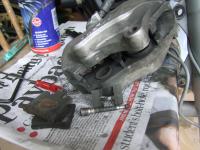I feel like gixxerjasen about the linked brakes. I'd rather make my own decision. I know the linked brakes are there to take care of people who don't know how to or refuse to use the front, but comparing the plumbing for the brakes on my ZRX to the plumbing and electronics on the FJR just makes me shake my head in wonder.
It's interesting to read these comments from you and Jasen. To me they are reminiscent of the types of things we used to hear from car drivers when ABS was first introduced ("I'd rather be in control", etc.). It wasn't stated expressly in the IIHS study referenced at the start of this thread, but I suspect that it was partly intended to address these sentiments. The people at the IIHS had probably heard similar statements and decided to see what the evidence says. Their conclusion is that overall, taking into account riders of all abilities, and not just experienced riders like you guys, ABS + linked brakes = fewer collisions and lower medical bills than just ABS alone.
I will say that it's worth noting, however, that the IIHS doesn't say anything about complexity vs. simplicity/cost of production/maintenance, etc. They're only concerned with on-road impacts and medical bills.
I'm sure there will be more studies done and further advances in technology, but if I had to bet I'd say linked brakes are here to stay for a good long while.




